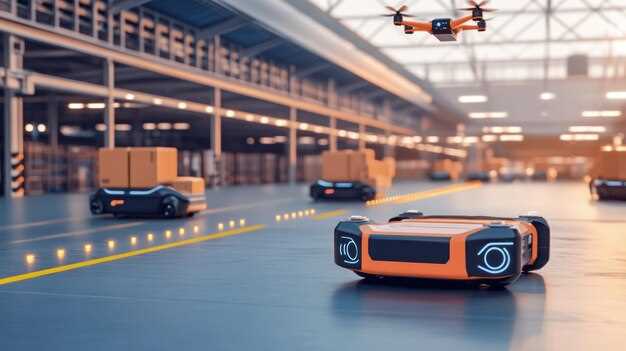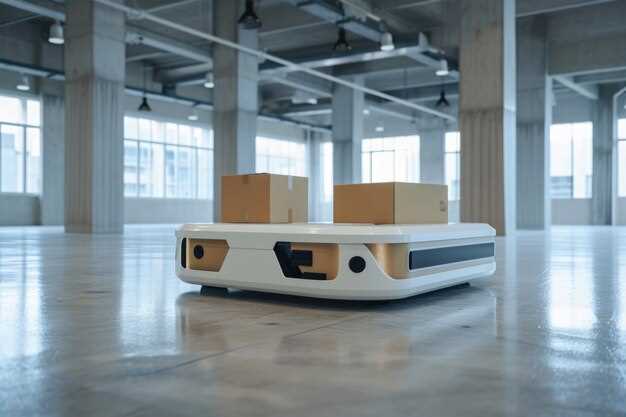Recommendation: Start phased adoption of driverless movers paired with robust analytics to cut travel time, boost items throughput, and improve accuracy across daily processes.
Early studies reveal rising throughput when driverless movers work alongside people in organized cycles; incident rates often drop by 20–30% with risk controls and standardized handoffs, known from field data.
In arkansas facilities, a pilot reduced travel distances by 14% and increased items picking accuracy by 10%, illustrating how both automation and human skill become coequal assets.
Collaboration between operators and driverless movers enables those gains to scale; also, a plan to accelerate adoption keeps momentum, supported by analytics and standardized procedures.
Knowledge from industry players, including vanderlande, said that accelerating modular fleets is central; latest studies indicate reliable performance when incident risk is anticipated and mitigated with predefined playbooks.
To track progress, analytics dashboards monitor travel of items, dwell times, also energy use; rising resilience comes from real-time data combined with knowledge sharing across teams.
Bottom line: adoption of driverless movers in controlled pilots, supported by latest analytics, tends to deliver measurable gains in speed, accuracy, and safety when teams maintain collaboration and continuous learning. As known from field results, benefits include lower incident rates and smoother items travel across routes.
Warehousing in the Age of Autonomous Vehicles
Recommendation: Launch a staged deployment across two areas within a single facility, integrating robotics with human oversight to ensure redundancy; target a 20% decrease in cycle times within 90 days, and monitor delays, accuracy, and throughput to guide expansion; look for opportunities to create better processes and safer work environments for people.
Key enablers include real-time data, modular hardware, and operator training. Studies from firms with deployments show faster task completion, better accuracy, and excellence in service. Developments in robotics and AI already provide paths to cut delays and support sustainable operations. Weather resilience becomes a requirement for continuous flow in warehouses during snow or other disruptions. Also, engage people in cross-training to boost adaptability.
- Scope & roles: select two areas, assign robotics tasks (picking, packing, inbound) and maintain people as main fallback; ensure redundancy; look for quick fault recovery.
- Deployment plan: schedule with last-mile integration; emphasize data sharing, real-time visibility; drive improvements in accuracy and speed.
- Weather readiness: ensure sheltered corridors, charging, and contingency staffing for snow; adjust routes, suspend nonessential moves during severe weather.
- Metrics & governance: track delays, drop in cycle time, decrease in error rate, and improvements in customer satisfaction; align with expectations from studies; define requirement for each phase.
- Scale & transform: after success, expand across more areas of warehouses; maintain sustainable energy use; evaluate improvements in outlook and form of operation; aim for excellence.
Optimizing Inventory Slotting and Sortation with Autonomous Vehicles

Recommendation: initiate a phased pilot using driverless shuttles to carry items from receiving to dynamic slotting lanes, starting in a large area with 2–3 sorting corridors. Define timelines of 8–12 weeks, measures time-to-slot updates, throughput, and space utilization, and compare against baseline.
Implement dynamic slotting rules based on demand signals, drawing from sensors and orders, and establish collaboration between operations, IT, and suppliers. Utilize APIs for communications between controller and shuttles, enabling rapid adjustments without manual rework; set policies that cover safety, privacy, and fail-safes. Evaluate studies from other facilities to refine parameters. This approach reduces idle cycles, which boosts efficiency.
Slotting strategy prioritizes large SKUs near docks, mid-sized items in mid aisles, and small fast-moving items in flexible pockets to minimize carry distance. Use path planning to optimize routes, and design service loops enabling multiple shuttles to operate in parallel. Apply potentially safer routing modes during peak demand, which reduces idle travel.
Communications cadence underpins success: sent alerts to human operators, real-time dashboards, and cross-functional updates. Also establish daily standups with collaboration across teams to refine slotted zones.
Policy development should explicitly enable utilizing driverless transport in service of order demand; align with safety and privacy standards; define commissioning milestones and timelines. This framework supports being responsive to demand and enables quick iteration; early wins from small tests build confidence and demonstrate measurable reductions in travel time.
Metrics should cover large gains in carry efficiency, improved pick accuracy, and reduced dwell times; measure time-to-slot, demand coverage, and response rate to changes. Effectively track KPIs by aggregating data from shuttles, sensors, and orders. Compare against baseline studies to confirm progress toward success.
Challenges include sensor drift, tag misreads, congestion during peak shifts, and integration lag with existing control systems. Address via redundant sensors, robust fault handling, phased rollouts, and ongoing collaboration with vendors and service providers. Establishing clear governance accelerates adoption. This also supports being adaptive as operations scale, and helps make adjustments faster.
Path forward: establish a scalable path for expansion across multiple facilities; publish findings to guide other operators; monitor advancements in AI for route optimization and robot control. Such measures, potentially, extend benefits to large facilities. Results may seem modest at first, yet impact compounds as more sites adopt.
Sensor Suite Requirements for Safe Navigation in Packed Warehouses
Install layered sensor suite: a 3D LiDAR sensor with 360° coverage and 0.1–0.2 m resolution, 40 m detection range; high‑resolution cameras (≥2 MP per channel) for texture and color; mmWave radar at strategic corners for occlusion resilience; ultrasonic sensors at pallet feet for close‑range checks; integrate inertial measurement unit and wheel encoders; ensure data streams are time‑synchronized and fused on an edge computer with latency under 50 ms and update rate 20–30 Hz; implement automatic braking triggered by perception outputs to prevent collision; set a practical number of redundant sensors to balance cost and resilience.
Technical fusion stack should deliver robust localization via LiDAR‑camera SLAM with drift under 0.02 m per meter in structured zones; maintain high detection reliability for moving humans, forklifts, and pallets even when line of sight is compromised; use probabilistic fusion to resolve conflicts among sensors and reduce false positives; maintain continuous operation during partial sensor outages to preserve safety and efficiency; this stacking yields a scalable solution for safe navigation in dense layouts, and inroads toward broader automation.
A survey of past deployments shows including radar alongside LiDAR and cameras boosts critical detection rates by 15–25% in crowded sections and lowers incident frequency; a finding underlines redundancy value to continue movements without interruption; better perception fidelity supports better path planning in complex layouts while reducing risk.
Procure baseline sensors and negotiate bundle pricing with vendors; estimate total cost and ongoing maintenance; allocate spare parts and calibration cadence; run a pilot in a single zone; collect data and compare against baseline to compute cost-benefit index; if index exceeds 1.5, ROI justifies scale; otherwise adjust scope to address opportunities in transportation throughput and safety.
Before procurement, perform a site survey of aisle widths, shelf heights, floor conditions, and traffic patterns; define performance targets, testing protocols, and data handling for central analytics; implement a measurement plan for localization accuracy, detection rate, and reaction time; after deployment, continue monitoring via dashboards; data is sent to central systems for ongoing learning and tuning.
Other considerations: rugged hardware tolerant to dust and vibration; auto‑calibration routines; schedule for recalibration; compatibility with existing transport fleets and warehouse robots; safety oversight and compliance with internal standards; continuous improvement loop to adapt to layout changes and seasonal workload spikes.
Real-Time Data Fusion for Accurate Positioning and Perception
Recommendation: implement real-time data fusion stack combining data from routing, sensors, and apis to deliver centimeter-level positioning and robust perception. Prioritize edge-processing to minimize latency and maintain speed of updates.
Reality alignment hinges on multi-sensor fusion: vision, lidar, radar, IMU, and map data. Use probabilistic fusion to sustain mind-level estimation accuracy, resilient to occlusions and ad hoc changes in environment. This approach supports reshaping operations of teams by delivering reliable positioning even when lighting or dust obstructs sensors, elevating excellence in situational awareness, and enabling faster adoption cycles.
Interfaces between sensors, edge devices, and cloud must be standardized; adopt modular apis and common data models to accelerate integration. Innovations in routing, congestion management, and priority queuing reduce jitter; suitable designs meet requirement for reliability in harsh environments and support adoption by firms investing in digital twins and simulations that operate under variable conditions.
Speed of data fusion translates into actionable decisions within last meters of movement. Establish well-defined requirement benchmarks: latency under 20 ms, drift under 0.03 m/s, and data freshness within 50 ms for high-traffic zones. Leverage edge compute to maintain reliability during congestion and when centralized networks degrade.
Adoption accelerates when professionals integrate fusion layers into existing workflows, having clear value cases and measurable KPIs. Firms investing in training, simulations, and governance reduce risk and accelerate ROI. Investment in standardized interfaces, robust sensing, and scalable apis creates a foundation for ongoing innovations, enabling order-driven routing decisions that optimize assets, reduce congestion, and sustain high service levels, delivering excellence across operations.
AI-Driven Task Allocation and Dynamic Routing for AVs and Human Operators

Start with a baseline that measures idle time, distance traveled, dock wait, and service level by customer. A good baseline plus AI-driven task allocation delivers tangible gains in congestion reduction and reliability.
Using intelligence from sensors, logs, and environment context, implement a multi-objective optimization that minimizes idle time and travel distance while preserving safety. Decision-making should be transparent, with measures that track throughput, health indicators, and customer satisfaction.
Routing logic should consider number of active agents, startup times, and expected congestion on highway segments and internal lanes. Using latest hardware and edge computing, dynamic routing allows reallocation within milliseconds, thus reducing idle time and improving throughput.
Process design includes a two-layer approach: allocation then rerouting. Measures include congestion reduction, reliability, dock health, and customer wait times. Where dock capacity shifts, those assets should trigger alternative plans and notify customers automatically.
Decision rules should reflect factors like dock availability, demand patterns, and asset health, shaping allocations accordingly.
Health signaling and hardware health checks guide decisions. This environment-aware approach should decrease congestion around bottlenecks by routing through smoother segments, supporting transportation efficiency and customer experience. Therefore, planners can scale operations without sacrificing safety.
Technological type underlying capability relies on probabilistic forecasting, sensor fusion, and robust hardware. Latest sensors and edge devices boost reliability and reduce cloud load, enabling rapid decision-making at speed.
Implementation measures: run pilots on a 2–3 week cycle, track number of reassignments per hour, measure congestion indices, and compare to baseline. Success indicators include reduced average task cycle time, improved health signals, and higher customer satisfaction.
Great potential exists for cross-docking and last-mile flows with AI guidance.
From Pilot Programs to Full-Scale Deployment: Practical Change Management
Recommendation: Establish a phased, five-step rollout with a cross-functional group of managers and professionals, establishing governance, decision-making cadence, and budgets aligned with needs.
What matters in this transition is efficiency achieved through timely, data-backed decision-making; link pilots to full-scale deliverables by building a learning loop that connects understanding with concrete outcomes.
Five levers drive results: people (professionals and managers), processes, trucks and technology, data, and financing; five is explicit to ensure focus on five areas.
Establishing a governance forum introduced well before rollout will help manage threats, budgets, and expectations, according to needs from facility layout and routing requirements.
Between pilots and scale, managers should track what matters: images of layout changes, efficiency metrics, and timely deliverables; this strengthens understanding of associated risks and critical dependencies in this realm.
Story-driven communication accelerates adoption: share five concise case studies, each with learning, budgets, and roadmaps; this approach drives confidence among managers and professionals.
In practice, a well-structured change plan reduces threats and accelerates delivery, while maintaining a focus on what stakeholders need; color-coded images and dashboards help drive comprehension and timely actions.
| Oblast | Guidance |
| Governance | Establish cadence; assign managers and professionals; intro training |
| Measurement | Track efficiency, decision-making, timely deliverables; use five metrics |
| Technology & Trucks | Leverage sensors, routing, and fleet management to support reliability |
| Budget & Change | Define budgets early; monitor costs; align with needs |
| Learning | Capture associated insights; maintain a story of progress |

 Are Autonomous Vehicles the Solution to Warehouse Operational Challenges?">
Are Autonomous Vehicles the Solution to Warehouse Operational Challenges?">
